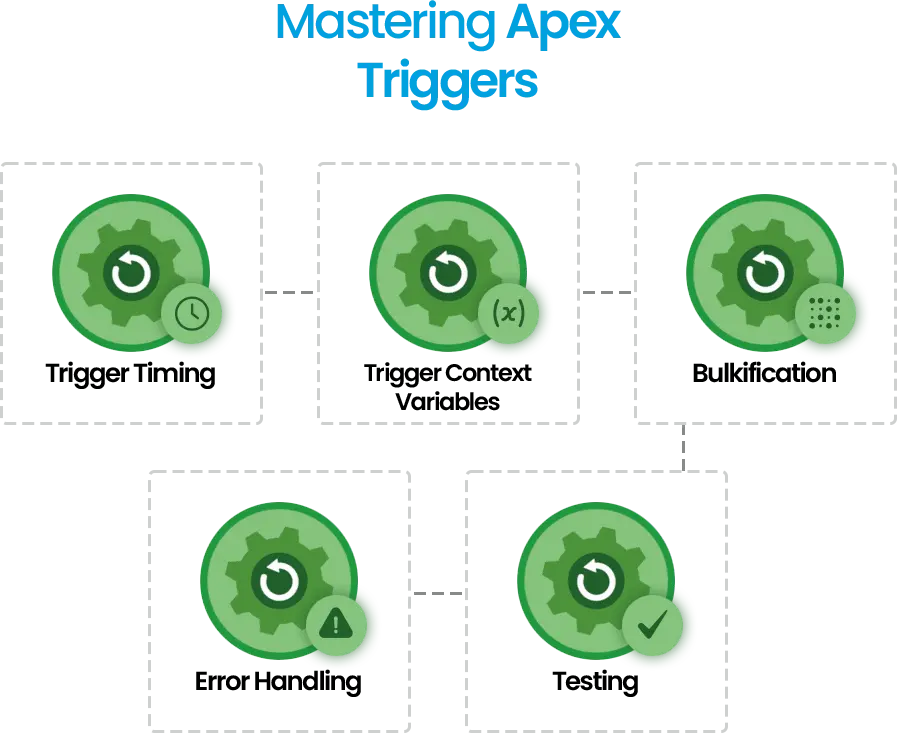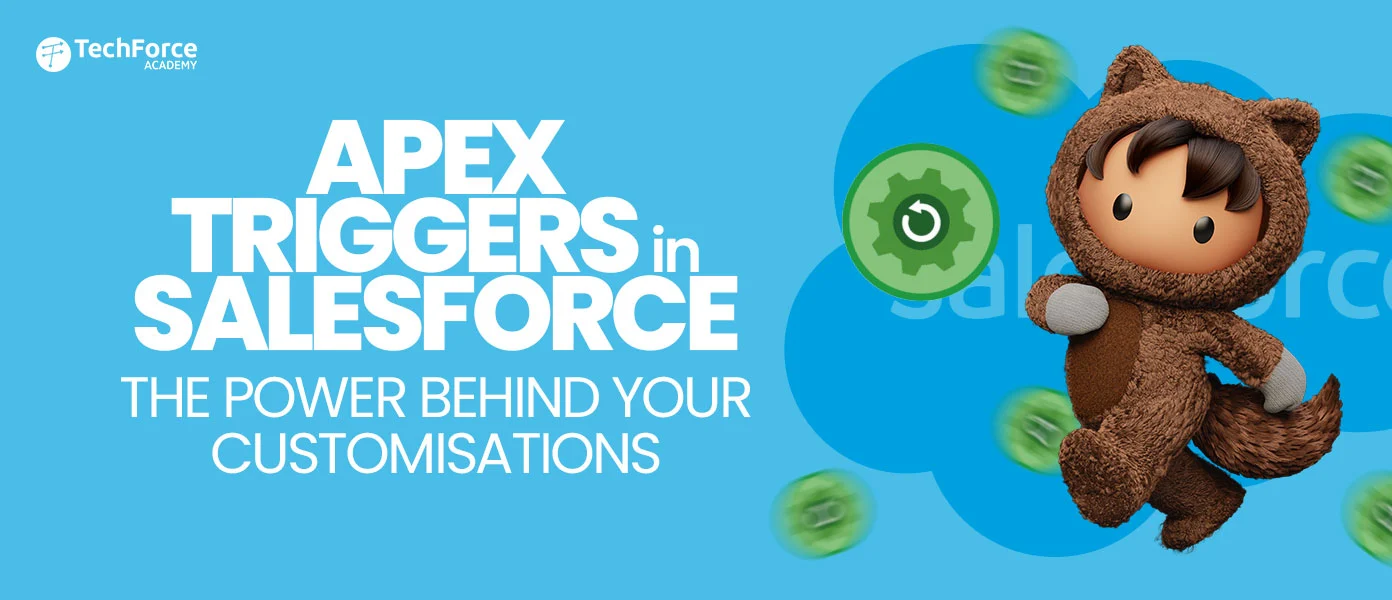Salesforce is known for its effective out-of-the-box automation skills, however, every so often, you want that greater degree of control and flexibility. That’s where Apex triggers in Salesforce come into play. These code-based total automation are your secret weapon for crafting tailor-made answers that completely align with your specific business logic.
What are Apex Triggers in Salesforce?
In easy phrases, Apex triggers are snippets of code that routinely execute in response to unique activities inside your Salesforce org. These events can be record creations, updates, deletions, or even undo deletions. Think of them as vigilant sentinels watching over your records prepared to spring into motion each time something noteworthy takes place.
When Should You Unleash the Power of Triggers?
While Salesforce gives declarative automation equipment like Process Builder and Flows, Apex triggers excel in situations in which you need:
>> Complex Logic
If your automation entails difficult calculations, multi-step procedures, or decision-making primarily based on multiple criteria, triggers are your pleasant wager. They can deal with scenarios that declarative tools would possibly struggle with.
>> Custom Actions
Need to carry out movements not natively supported by using Salesforce? Triggers can call custom Apex training, integrate with outside systems, or control records in ways that different automation cannot.
>> Real-Time Validation
Want to put into effect strict statistics and exceptional regulations or save your invalid statistics from being saved? Triggers can validate records before it’s devoted to the database, ensuring consistency and accuracy.
>> Performance Optimisation
In situations wherein bulk data processing is required, well-written triggers can often outperform declarative automation tools.
Trigger vs. Other Salesforce Automation: A Quick Comparison

|
Feature |
Apex Triggers |
Process Builder |
Flows |
Workflow Rules |
|
Complexity |
High |
Medium |
Medium to High |
Low to Medium |
|
Customisation |
Maximum |
Limited |
Medium |
Limited |
|
Performance |
High (when optimised) |
Moderate |
Moderate to High |
Moderate |
|
Real-Time Validation |
Yes |
Yes |
Yes |
Yes |
|
Custom Actions |
Yes |
Limited |
Yes |
Limited |
|
Bulk Processing |
Yes |
Yes |
Yes |
Limited |
|
Debugging |
Easier (code-based) |
Moderate |
Moderate |
Moderate |
Real-World Trigger Use Cases
Here are some practical examples where triggers prove their worth:
Lead Assignment
The capabilities for automatically assigning leads to the correct sales rep by territory, industry, or source are provided.
Opportunity Updates
Perform calculations, send email/Salesforce.com notifications or invoke actions based on Opportunity being at a particular stage.
Account Management
Ensure that data validation rules are implemented when records are created, constrain the creation of duplicated records or trigger related records’ updates when the accounts are altered.
Custom Object Automation: 501
Enhance your custom objects in order to include triggers which should perform some concrete actions every time there are created/modified/deleted records.
A Word of Caution: Handle with Care!
It is important to note that triggers are truly amazing but they must be treated with technique. In another way, the triggers are written poorly because they affect performance, lead to mistakes, or even cause the org to collapse.
Thus, it is advised to keep abreast of the widely accepted standards, reduce redundancy, ensure code readability and organisation, and perform comprehensive testing with the newly developed triggers before their implementation to the final stages.
Embrace the Power of Salesforce Apex Triggers
In my opinion, if you are integrating automation within the Salesforce platform, then Apex triggers are a must-have tool among them. They provide the freedom, ownership and individuality, which can be so vital in achieving your ideal applications within an organisation.
Beyond the Basics: Mastering Apex Triggers

Now that you have a grasp of when triggers are the right tool, let’s dive deeper into some crucial concepts for crafting effective triggers:
1. Trigger Timing
It can be clearly seen that there are significant differences between the state and the situation before and after the passage of the law.
There are two flexible mechanisms in triggering by which certain triggers can be run before or after a database operation is carried out. Before triggers are ideal it is required that data is validated, field values are set to default, and where an operation is unlikely to progress when executed.
Triggers are beneficial after events for updating other records that are connected, summarising active roll-up details, or submitting actions predicated on the record’s ultimate state.
2. Trigger Context Variables
Context variables are available if your trigger is armed and activated. Such variables inform you whether the operation was an insertion, an upgrade, or a deletion; whether the trigger is to be initiated before the database transaction or after the same; and the old respectively new records.
While this information is quite useful in general, it is particularly essential if you need to customise your trigger logic for certain situations.
3. Bulkification
Among the performance conditions of an aircraft, the following is a must:
Through big data, Salesforce is made to take in a large amount of data. Due to the tendency to hit performance issues and governor limit errors, it is crucial to ‘bulkify’ your trigger coding. This means ensuring your trigger can handle multiple records at once, rather than having only one record to work on all the time.
4. Error Handling
A good presentation of failure or failure to present the success.
Sometimes introduces some form of deviation from the norm, though it seldom occurs in the Salesforce environment. Triggered should be able to identify and effectively respond or behave correctly when errors occur. This involves:
- The handling of exceptions It will be possible to use the try-catch blocks of the programming language to catch these exceptions.
- This can be done using the WriteApplicationErrors setting to log errors for the purpose of debugging with LOG_FILE.
- Possibly alerting the users or administrators in case of an Error.
5. Testing
Having it Double Checked to Make Sure All Your Triggers Operate As Expected
When we write a trigger, as with any other code, we need to pay a lot of attention to its testing. To ensure that your trigger actions work correctly, you need to write unit tests for your MRU lists and trigger logic with respect to different conditions.
Testing lets you identify problems when they are not production time, so you do not encounter such slips when your triggers are in the production servers.
Best Practices for Trigger Development

Following these best practices will help you write clean, maintainable, and high-performing Apex triggers:
Modularity
Try to split your logical triggers into smaller methods for reuse. It’s less complex as it organises your code for enhanced readability, traceability for modification, and testability.
Separation of Concerns
This means that your trigger code should not include detailed implementation details and low-level application details. Split tasks or calculations into simpler sub-tasks as helper classes or methods to deal with them.
Avoid SOQL and DML Inside Loops
Avoid calling SQL/SOQL queries and updates (DML) inside loops to minimise issues on performance.
Leverage Platform Events
For conditionally asynchronous processes of high complexity, where the trigger execution might be time-consuming, you can change the handling code to make use of Platform Events and avoid ‘stripping’ the database transaction.
Points to remember
- Triggers are your trusted allies for complex logic, real-time validation, custom actions, and performance optimisation.
- Choose the right tool for the job. Triggers aren’t always the answer – sometimes, declarative tools like Process Builder or Flows are more suitable.
- Master the fundamentals: understand trigger timing, context variables, bulkification, error handling, and testing.
- Adhere to best practices to write clean, maintainable, and efficient trigger code.
Your Salesforce Journey Continues
The world of Apex triggers is vast and ever-evolving. As you delve deeper into Salesforce development, you will discover even more advanced techniques and patterns to elevate your automation game. Embrace the learning process, and experiment, and do not hesitate to seek guidance from the vibrant Salesforce community.
With the right knowledge and a dash of creativity, you can leverage Apex triggers to transform your Salesforce org into a finely-tuned machine that perfectly aligns with your unique business needs. Happy coding!











